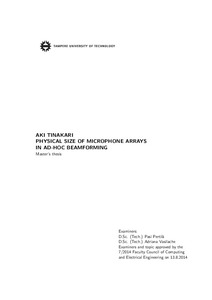Physical size of microphone arrays in ad-hoc beamforming
Tinakari, Aki (2017)
Tinakari, Aki
2017
Tietotekniikka
Tieto- ja sähkötekniikan tiedekunta - Faculty of Computing and Electrical Engineering
This publication is copyrighted. You may download, display and print it for Your own personal use. Commercial use is prohibited.
Hyväksymispäivämäärä
2017-12-07
Julkaisun pysyvä osoite on
https://urn.fi/URN:NBN:fi:tty-201711222212
https://urn.fi/URN:NBN:fi:tty-201711222212
Tiivistelmä
Microphone arrays can be used to record an event, for example speech during a meeting in meeting room setting. Besides the wanted signal, the speech, these audio recordings also have noise in them that is caused by various sources, including unwanted sound sources in the room, reflections and reverberations from the room itself, and noise caused by the equipment used to measure the speech. The audio recordings from the microphones can be intelligently combined with beamforming so that the information from the target event is lined up, and added up so that the result signal is an enhanced combination of all the measured recordings. This results to significantly more clear recording than any single recording of the speech.
In this thesis some of these beamforming methods are studied, as well as how they can be used with speech signals in a meeting room scenario, how the system is able to work ad-hoc when the location of the devices is omitted, and also how the physical dimensions of the array affect the beamformer output. The research focuses on a meeting room scenario, and utilizes both simulations and real recordings to show that there is an optimal size to the microphone array diameter in the studied scenario.
In this thesis some of these beamforming methods are studied, as well as how they can be used with speech signals in a meeting room scenario, how the system is able to work ad-hoc when the location of the devices is omitted, and also how the physical dimensions of the array affect the beamformer output. The research focuses on a meeting room scenario, and utilizes both simulations and real recordings to show that there is an optimal size to the microphone array diameter in the studied scenario.
